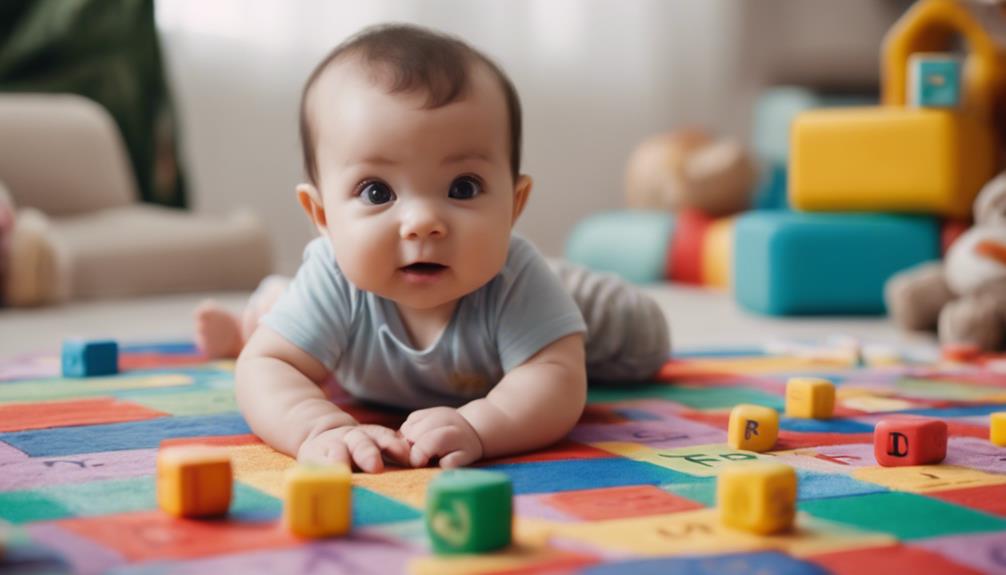Enhance your baby’s early alphabet learning journey by associating sounds with familiar words like ‘A for apple.’ Gradually introduce new letter sounds through engaging activities such as sound recognition games. Enhance their tactile experience by using magnetic letters for interactive learning. Tailor your approach to your baby’s interests, encouraging child-led exploration of letters. Consistent practice along with play will help reinforce their learning. Explore alphabet books and interactive games to further engage them. Incorporate alphabet learning into daily activities for seamless integration. Use alphabet songs to create an interactive learning experience. There are more techniques available for your baby’s learning journey.
Key Takeaways
- Use sound association with familiar words like 'A for apple' for effective learning.
- Introduce one letter sound at a time through engaging activities.
- Incorporate hands-on magnetic letters for interactive learning experiences.
- Adopt a child-led approach that caters to your baby's interests.
- Balance consistent practice with playful activities for a fun learning environment.
Sound Association With Memorable Words
Associate each letter sound with a memorable word to enhance your baby's learning experience and boost their language development skills. When introducing the alphabet to kids, teaching sound association is an important step. By linking each letter to a familiar and easily recognizable word, such as 'A for apple' or 'B for ball,' you create a strong foundation for alphabet recognition.
These memorable words help your baby connect the sound of each letter to something concrete and relatable, making the learning process engaging and effective.
For example, when teaching the letter 'C,' associating it with the word 'cat' can help your baby not only remember the sound but also visualize and understand the concept better. Creating a fun and interactive environment by incorporating playful words like 'dinosaur' for 'D' or 'elephant' for 'E' can make learning the alphabet enjoyable for your little one.
Through sound association with memorable words, your baby can develop language skills and lay the groundwork for further literacy development.
Introducing New Letter Sounds

When introducing new letter sounds to your baby, remember to keep it simple and focus on one sound at a time.
Use engaging activities like sound recognition games and interactive letter games to make learning fun.
Repetition is key to reinforcing these new sounds in your baby's developing language skills.
Sound Recognition Activities
How can you effectively introduce new letter sounds to your baby through sound recognition activities? Start by focusing on one letter at a time to prevent confusion and aid comprehension. Utilize fun games and activities that associate the sound of each letter with memorable words or objects. Encourage your baby to imitate the sounds you make when introducing a new letter, reinforcing their understanding of the sound. Regular repetition of these activities is key to solidifying their learning and retention of the letter sounds. Keeping the activities engaging and interactive will help maintain your baby's interest in learning new sounds.
| Letter Sound | Memorable Word/Object | Activity |
|---|---|---|
| A | Apple | Make 'A' sounds with apple slices during snack time |
| B | Bear | Growl like a bear when saying the letter 'B' |
| C | Cat | Meow like a cat for the letter 'C' |
Interactive Letter Games
To continue building on your baby's understanding of letter sounds, engage them in interactive games that make learning fun and memorable. Interactive letter games offer a playful way for your baby to explore new letter sounds. These games can involve matching letters, identifying letter sounds, and even tracing letters. By incorporating these activities, you aren't only introducing your baby to the alphabet but also helping them develop cognitive skills and memory retention.
Hands-on letter games provide a tactile learning experience, which enhances letter recognition and understanding.
Through play-based learning with interactive letter games, your baby can enjoy the process of learning new sounds. These games create an engaging environment where your little one can actively participate and learn at the same time. Encouraging interactive play with letters can stimulate your baby's curiosity and promote a positive attitude towards learning.
Repetition for Reinforcement
Engage your baby in frequent practice sessions to reinforce new letter sounds effectively. Repetition is vital in helping your little one grasp and retain these fundamental building blocks of language.
By consistently exposing your baby to different letter sounds, you're aiding in the development of strong neural connections in their brain. This repetitive exposure not only enhances memory retention but also deepens their understanding of the sounds each letter represents.
Through regular practice, your baby will gradually start recognizing and verbalizing these letter sounds more confidently. This familiarity with letter sounds sets a solid foundation for their language development journey.
Hands-On Activities With Magnetic Letters
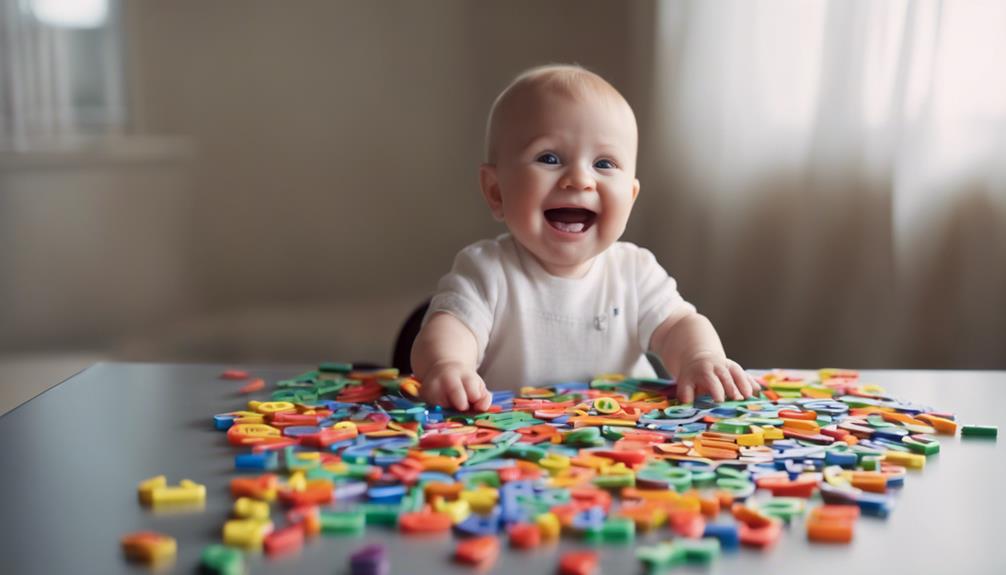
One effective way to introduce your baby to the alphabet is through hands-on activities using magnetic letters. Magnetic letters provide a tactile and interactive experience that can engage your baby's senses while learning.
Here are some tips for incorporating magnetic letters into your teaching routine:
- Use a cookie tin as a magnetic surface to create a hands-on learning environment.
- Associate each magnetic letter with a corresponding sound and word to reinforce learning.
- Focus on introducing one new magnetic letter at a time to prevent overwhelming your baby.
- Encourage your baby to touch and play with the magnetic letters to enhance the learning experience.
- Consider watching video demonstrations to learn how to effectively utilize magnetic letters in teaching the alphabet.
Child-Led Learning Approach
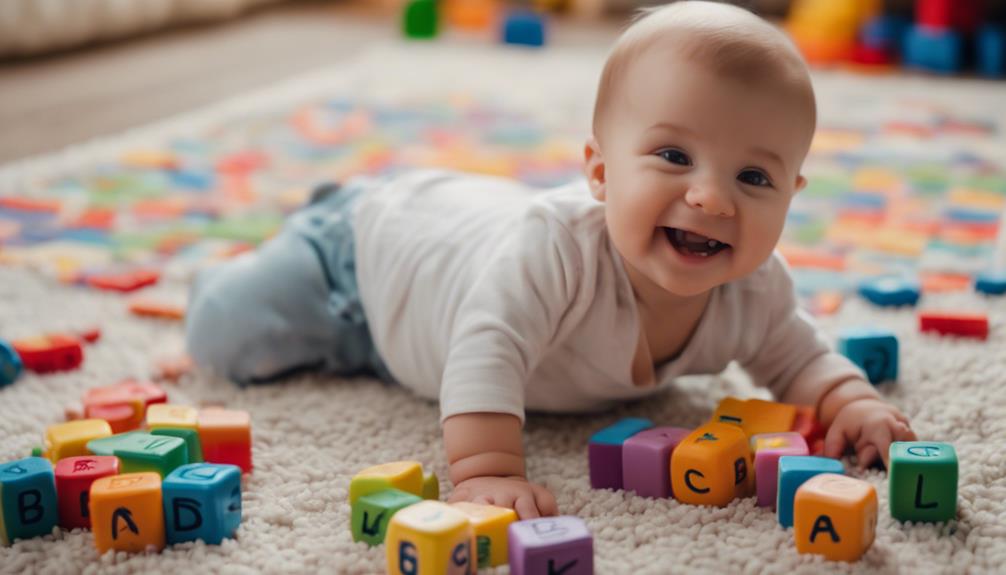
How can you tailor your teaching approach to your baby's interests in the alphabet learning process? By adopting a child-led learning approach, you can cater to your little one's curiosity and pace in exploring letters. This method empowers your child to take the lead in their alphabet learning journey, fostering a sense of independence and enhancing their engagement with the subject. Through child-led learning, your baby can develop a strong connection with the alphabet as they actively participate in activities that align with their interests.
To understand the benefits of a child-led learning approach further, let's explore a comparison of traditional versus child-led methods:
| Traditional Approach | Child-Led Approach | Benefits |
|---|---|---|
| Teacher-driven instruction | Child-guided exploration | Encourages independence |
| Structured lesson plans | Flexible learning pace | Enhances engagement |
| Focus on curriculum goals | Personalized learning path | Fosters a love for learning |
Consistent Practice and Play Balance

Tailoring your teaching approach to your baby's interests in exploring the alphabet can be achieved by striking a balance between consistent practice and play. Here are some key points to keep in mind when finding this equilibrium:
- Learn the Letters: Make sure your baby is exposed to the alphabet regularly through activities like singing the ABC song or pointing out letters in everyday objects.
- Fun Ways to Teach: Incorporate games, puzzles, and interactive activities to make learning the alphabet enjoyable and engaging for your little one.
- Help Them Learn: Offer gentle guidance and positive reinforcement as your baby navigates the world of letters, creating a supportive learning environment.
- Consistent Practice: Establish a routine where alphabet practice is integrated into daily activities to reinforce letter recognition and sound association consistently.
- Play Balance: Remember to keep the atmosphere light and fun during learning sessions to maintain your baby's interest and motivation in exploring the alphabet.
Reading Alphabet Books Together
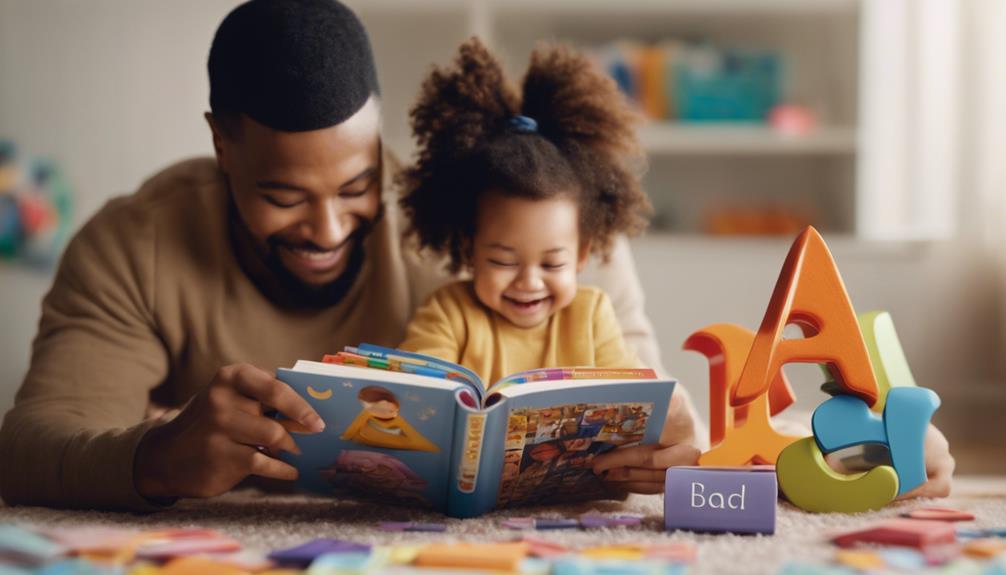
Reading alphabet books together with your baby can be a delightful way to introduce them to letters.
The colorful illustrations in these books make the learning experience visually engaging.
Associating each letter with a corresponding picture can aid in memory retention and letter recognition.
Interactive Alphabet Activities
Engaging in interactive alphabet activities by reading alphabet books together with your baby fosters an early love for letters and language. It's a fun activity that not only introduces the alphabet but also helps in learning the letter names, both uppercase and lowercase.
Here are some key benefits of incorporating alphabet books into your routine:
- Introduction to Letters: Reading alphabet books helps introduce letters in an engaging and interactive way.
- Uppercase and Lowercase Exposure: It allows for exposure to both uppercase and lowercase letters, aiding in letter recognition.
- Association with Pictures: Associating each letter with a specific picture can aid in memorization and understanding.
- Bedtime Routine: Incorporating alphabet books into bedtime routines can create a positive association with learning for your baby.
- Reading Success: Starting the alphabet journey positively with interactive activities sets the child up for reading success in the future.
Incorporating Letter Sounds
To enhance your baby's early literacy skills, consider incorporating letter sounds by exploring alphabet books together. Reading alphabet books can help teach the alphabet in a fun and engaging way, allowing your baby to learn letter sounds while bonding with you.
By pointing to the letters as you read, you can assist your baby in connecting the sounds to the visual representation of each letter. Opt for books with clear, bold letters and interesting illustrations to keep your baby engaged and interested in the learning process.
The repetition of reading alphabet books plays a significant role in reinforcing letter sounds and recognition. This practice helps your baby become familiar with the alphabet and sets a strong foundation for future reading skills.
Make the most of this time together to introduce the world of letters and sounds in an enjoyable and educational manner.
Engaging Alphabet Games
Discover the joy of exploring alphabet books with your baby, fostering early literacy skills through interactive learning activities. Engaging in alphabet games while reading together can be a rewarding experience for both you and your little one.
Here are some tips to make the most out of reading alphabet books:
- Create a scavenger hunt for letters in the book, encouraging your baby to find and point to specific letters as you read.
- Sing the alphabet song together while pointing to each letter in the book, reinforcing letter recognition through music and movement.
- Ask questions about the letters and their sounds, prompting your baby to engage with the material and enhance their understanding.
- Use alphabet games like 'I Spy' to search for objects that start with a certain letter, promoting early literacy and vocabulary development.
- Rotate different alphabet books to keep the learning experience fresh and exciting, exposing your baby to a variety of letter learning techniques and styles.
Incorporating Alphabet in Daily Activities

Integrate alphabet letters seamlessly into your daily routines to foster early learning in a natural and engaging way. By incorporating alphabet letters into activities like bath time, meal prep, and playtime, you create a familiar learning environment that helps your baby recognize letters effortlessly. Utilize alphabet flashcards during transitions or downtime to introduce letters consistently and casually. Labeling everyday objects with alphabet stickers or magnets associates letters with real-world items, aiding in letter recognition. Singing alphabet songs during car rides or walks not only makes learning fun but also interactive, enhancing your baby's engagement with the letters. To further enrich the learning experience, consider creating alphabet-themed sensory bins where letters are hidden in various materials, providing a tactile learning experience that reinforces letter identification. Embrace these simple yet effective methods to seamlessly integrate alphabet learning into your daily activities.
| Daily Routine Activities | Recommended Alphabet Integration |
|---|---|
| Bath Time | Use alphabet bath letters |
| Meal Prep | Label ingredients with letters |
| Playtime | Play alphabet games |
| Transitions/Downtime | Flashcards or alphabet books |
| Car Rides/Walks | Sing alphabet songs together |
Engaging With Alphabet Songs
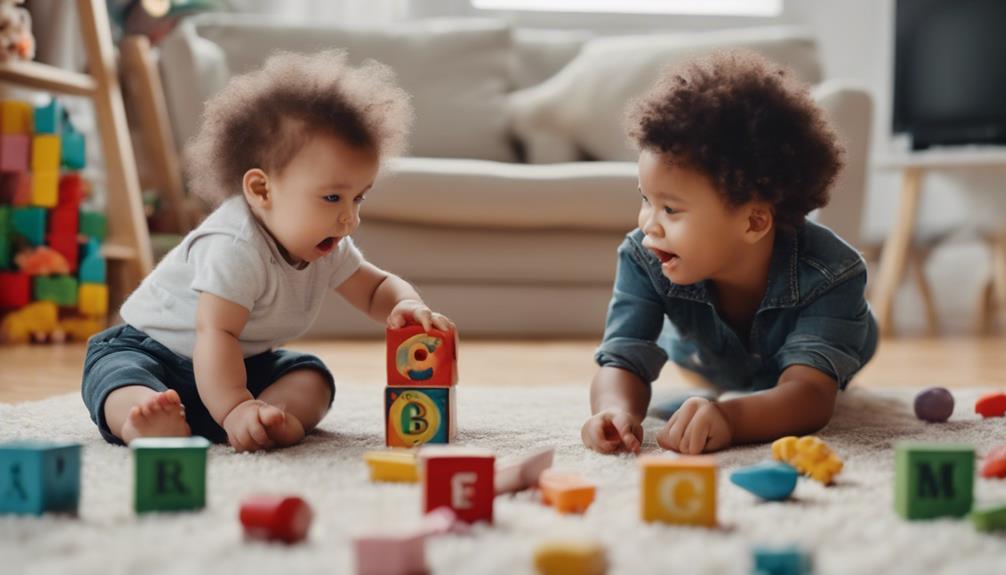
Engage your baby with alphabet songs to foster a fun and interactive learning experience that helps them grasp the rhythm of letters effortlessly. Singing alphabet songs introduces letter sounds in a playful and engaging way, making it easier for your little one to connect with the alphabet.
Repetition of these songs aids in memory retention, helping your baby remember the sequence of letters more effectively. You can easily find alphabet songs on platforms like YouTube, offering a wide array of options to keep your baby entertained while learning.
Additionally, creating personalized alphabet songs with your baby's name or favorite things can make the learning process even more enjoyable and memorable. So, don't hesitate to incorporate these melodic learning tools into your daily routine to enhance your baby's early literacy skills.
Frequently Asked Questions
How to Start Teaching Baby Abc?
Start by introducing one letter at a time along with its sound and a memorable word. Use interactive tools like magnetic letters on a cookie tin. Focus on sounds your baby can make. Progress slowly to keep it engaging.
How Early Can Babies Learn Abc?
Early as six months, babies can begin absorbing ABCs. By 12 months, recognition starts. At 18 months, simple activities aid learning. Engage with songs, books, and games. Nurturing curiosity fosters natural development of ABCs.
How to Teach ABC to Kindergarten?
To teach ABC to kindergarten, engage them with interactive activities like games and songs. Encourage practicing writing letters and spotting them in daily life. Introduce both uppercase and lowercase letters gradually for thorough learning. Keep it fun and engaging!
How Do I Teach My Child ABC Order?
To teach your child ABC order, start by singing the alphabet song regularly. Use alphabet charts or flashcards for visual aid. Engage in games like puzzles or sorting. Try a fun scavenger hunt too!
Conclusion
To summarize, teaching your baby the ABCs early on is essential for their cognitive development. By incorporating sound association, hands-on activities, and consistent practice, you can help your little one build a strong foundation in literacy.
Remember, Rome wasn't built in a day, so be patient and stay consistent in your efforts. With time and dedication, your baby will be on their way to becoming a confident reader and learner.

